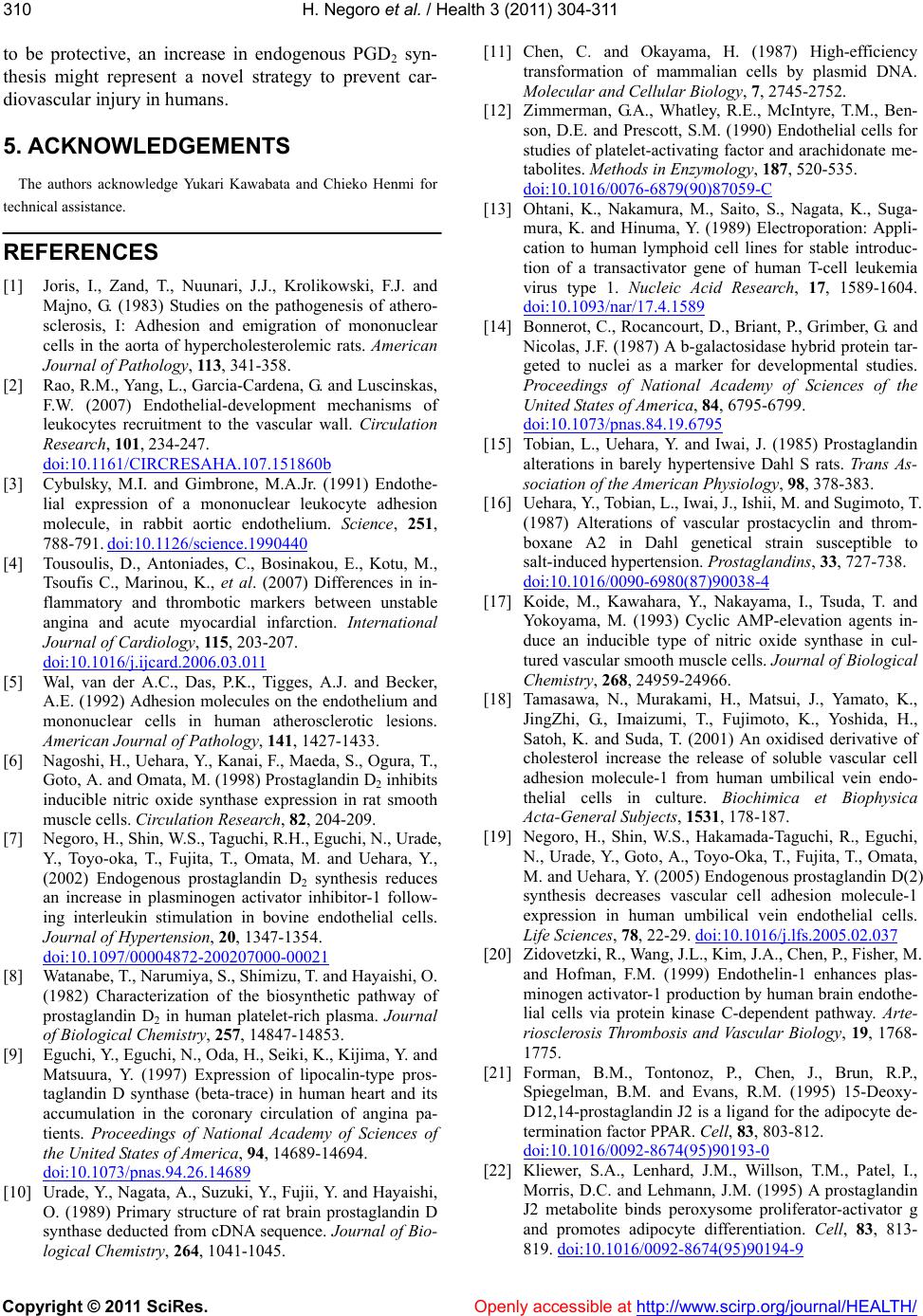
H. Negoro et al. / Health 3 (2011) 304-311
Copyright © 2011 SciRes. Openly accessible at http://www.scirp.org/journal/HEALTH/
310
to be protective, an increase in endogenous PGD2 syn-
thesis might represent a novel strategy to prevent car-
diovascular injury in humans.
5. ACKNOWLEDGEMENTS
The authors acknowledge Yukari Kawabata and Chieko Henmi for
technical assistance.
REFERENCES
[1] Joris, I., Zand, T., Nuunari, J.J., Krolikowski, F.J. and
Majno, G. (1983) Studies on the pathogenesis of athero-
sclerosis, I: Adhesion and emigration of mononuclear
cells in the aorta of hypercholesterolemic rats. American
Journal of Pathology, 113, 341-358.
[2] Rao, R.M., Yang, L., Garcia-Cardena, G. and Luscinskas,
F.W. (2007) Endothelial-development mechanisms of
leukocytes recruitment to the vascular wall. Circulation
Research, 101, 234-247.
doi:10.1161/CIRCRESAHA.107.151860b
[3] Cybulsky, M.I. and Gimbrone, M.A.Jr. (1991) Endothe-
lial expression of a mononuclear leukocyte adhesion
molecule, in rabbit aortic endothelium. Science, 251,
788-791. doi:10.1126/science.1990440
[4] Tousoulis, D., Antoniades, C., Bosinakou, E., Kotu, M.,
Tsoufis C., Marinou, K., et al. (2007) Differences in in-
flammatory and thrombotic markers between unstable
angina and acute myocardial infarction. International
Journal of Cardiology, 115, 203-207.
doi:10.1016/j.ijcard.2006.03.011
[5] Wal, van der A.C., Das, P.K., Tigges, A.J. and Becker,
A.E. (1992) Adhesion molecules on the endothelium and
mononuclear cells in human atherosclerotic lesions.
American Journal of Pathology, 141, 1427-1433.
[6] Nagoshi, H., Uehara, Y., Kanai, F., Maeda, S., Ogura, T.,
Goto, A. and Omata, M. (1998) Prostaglandin D2 inhibits
inducible nitric oxide synthase expression in rat smooth
muscle cells. Circulation Research, 82, 204-209.
[7] Negoro, H., Shin, W.S., Taguchi, R.H., Eguchi, N., Urade,
Y., Toyo-oka, T., Fujita, T., Omata, M. and Uehara, Y.,
(2002) Endogenous prostaglandin D2 synthesis reduces
an increase in plasminogen activator inhibitor-1 follow-
ing interleukin stimulation in bovine endothelial cells.
Journal of Hypertension, 20, 1347-1354.
doi:10.1097/00004872-200207000-00021
[8] Watanabe, T., Narumiya, S., Shimizu, T. and Hayaishi, O.
(1982) Characterization of the biosynthetic pathway of
prostaglandin D2 in human platelet-rich plasma. Journal
of Biological Chemistry, 257, 14847-14853.
[9] Eguchi, Y., Eguchi, N., Oda, H., Seiki, K., Kijima, Y. and
Matsuura, Y. (1997) Expression of lipocalin-type pros-
taglandin D synthase (beta-trace) in human heart and its
accumulation in the coronary circulation of angina pa-
tients. Proceedings of National Academy of Sciences of
the United States of America, 94, 14689-14694.
doi:10.1073/pnas.94.26.14689
[10] Urade, Y., Nagata, A., Suzuki, Y., Fujii, Y. and Hayaishi,
O. (1989) Primary structure of rat brain prostaglandin D
synthase deducted from cDNA sequence. Journal of Bio-
logical Chemistry, 264, 1041-1045.
[11] Chen, C. and Okayama, H. (1987) High-efficiency
transformation of mammalian cells by plasmid DNA.
Molecular and Cellul ar B iology, 7, 2745-2752.
[12] Zimmerman, G.A., Whatley, R.E., McIntyre, T.M., Ben-
son, D.E. and Prescott, S.M. (1990) Endothelial cells for
studies of platelet-activating factor and arachidonate me-
tabolites. Methods in Enzymology, 187, 520-535.
doi:10.1016/0076-6879(90)87059-C
[13] Ohtani, K., Nakamura, M., Saito, S., Nagata, K., Suga-
mura, K. and Hinuma, Y. (1989) Electroporation: Appli-
cation to human lymphoid cell lines for stable introduc-
tion of a transactivator gene of human T-cell leukemia
virus type 1. Nucleic Acid Research, 17, 1589-1604.
doi:10.1093/nar/17.4.1589
[14] Bonnerot, C., Rocancourt, D., Briant, P., Grimber, G. and
Nicolas, J.F. (1987) A b-galactosidase hybrid protein tar-
geted to nuclei as a marker for developmental studies.
Proceedings of National Academy of Sciences of the
United States of America, 84, 6795-6799.
doi:10.1073/pnas.84.19.6795
[15] Tobian, L., Uehara, Y. and Iwai, J. (1985) Prostaglandin
alterations in barely hypertensive Dahl S rats. Trans As-
sociation of the American Physiology, 98, 378-383.
[16] Uehara, Y., Tobian, L., Iwai, J., Ishii, M. and Sugimoto, T.
(1987) Alterations of vascular prostacyclin and throm-
boxane A2 in Dahl genetical strain susceptible to
salt-induced hypertension. Prostaglandins, 33, 727-738.
doi:10.1016/0090-6980(87)90038-4
[17] Koide, M., Kawahara, Y., Nakayama, I., Tsuda, T. and
Yokoyama, M. (1993) Cyclic AMP-elevation agents in-
duce an inducible type of nitric oxide synthase in cul-
tured vascular smooth muscle cells. Journal of Biological
Chemistry, 268, 24959-24966.
[18] Tamasawa, N., Murakami, H., Matsui, J., Yamato, K.,
JingZhi, G., Imaizumi, T., Fujimoto, K., Yoshida, H.,
Satoh, K. and Suda, T. (2001) An oxidised derivative of
cholesterol increase the release of soluble vascular cell
adhesion molecule-1 from human umbilical vein endo-
thelial cells in culture. Biochimica et Biophysica
Acta-General Subjects, 1531, 178-187.
[19] Negoro, H., Shin, W.S., Hakamada-Taguchi, R., Eguchi,
N., Urade, Y., Goto, A., Toyo-Oka, T., Fujita, T., Omata,
M. and Uehara, Y. (2005) Endogenous prostaglandin D(2)
synthesis decreases vascular cell adhesion molecule-1
expression in human umbilical vein endothelial cells.
Life Sciences, 78, 22-29. doi:10.1016/j.lfs.2005.02.037
[20] Zidovetzki, R., Wang, J.L., Kim, J.A., Chen, P., Fisher, M.
and Hofman, F.M. (1999) Endothelin-1 enhances plas-
minogen activator-1 production by human brain endothe-
lial cells via protein kinase C-dependent pathway. Arte-
riosclerosis Thrombosis and Vascular Biology, 19, 1768-
1775.
[21] Forman, B.M., Tontonoz, P., Chen, J., Brun, R.P.,
Spiegelman, B.M. and Evans, R.M. (1995) 15-Deoxy-
D12,14-prostaglandin J2 is a ligand for the adipocyte de-
termination factor PPAR. Cell, 83, 803-812.
doi:10.1016/0092-8674(95)90193-0
[22] Kliewer, S.A., Lenhard, J.M., Willson, T.M., Patel, I.,
Morris, D.C. and Lehmann, J.M. (1995) A prostaglandin
J2 metabolite binds peroxysome proliferator-activator g
and promotes adipocyte differentiation. Cell, 83, 813-
819. doi:10.1016/0092-8674(95)90194-9